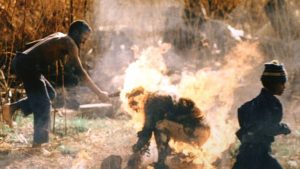

Image Source: allthatsinteresting
Have you ever seen something that changed the way you think? This post is a journey back to a pivotal moment in history. We’re talking about the Maki Skosana footage—a powerful reminder of our past. This story is about more than just a video; it’s about the people and the events that shape our world. So, let’s take a step back and see what this footage can tell us today. It’s a story that belongs to all of us, and it’s time we share it together. Join us as we look back, remember, and learn.
Maki Skosana was a young woman from South Africa. She was only 24 years old and had a little boy who was five. She worked in a factory to make a living for her and her son. Maki lived in a place called Duduza, which is near a city called Nigel in South Africa.
On July 20, 1985, something very sad happened to Maki. The incident captured in the Maki Skosana footage happened during a very troubled time in South Africa.
It was a time when people were fighting against unfair laws called apartheid, which separated people based on their race.
Maki Skosana was suspected by some people in her community of being a police informer. They thought she had something to do with the deaths of four young activists.
These activists were believed to have been killed by a secret group called the “Third Force,” which was thought to be made up of government operatives trying to control the resistance in the townships.
Because of these suspicions, a mob of anti-apartheid activists targeted Maki during a funeral for the activists who had died. They were very angry and believed that she had betrayed them.
So, they attacked her in a brutal way known as “necklacing,” where a tire is put around someone’s neck, filled with gasoline, and set on fire.
The Maki Skosana footage shows this terrible act and it was broadcast on television for many to see. It’s a harsh reminder of the violence that happened during those times and the lengths to which people went when they felt betrayed or threatened.
It’s important to remember that this footage is not just about Maki Skosana; it’s about understanding the history of South Africa and the struggles that people went through.
It teaches us about the dangers of suspicion and violence, and why it’s so important to always seek the truth and treat each other with respect.
The consequences of the incident involving Maki Skosana were significant and far-reaching:
The brutal manner of Maki Skosana’s death elicited widespread outrage and horror, both within South Africa and internationally. The graphic nature of the Maki Skosana footage broadcast on television brought the violence of apartheid resistance into the living rooms of people around the world, highlighting the extreme measures taken during the struggle.
The incident intensified the already high tensions between the apartheid government and the anti-apartheid activists. It underscored the deep divisions and the lengths to which individuals would go to fight against what they perceived as betrayal or collaboration with the apartheid regime.
The use of “necklacing” as a method of execution took a psychological toll on the communities. It was a stark reminder of the brutal reality of the conflict and the human cost of the struggle for freedom and equality.
The incident has been reflected upon in historical accounts as a dark chapter in the fight against apartheid. It serves as a reminder of the complexity of resistance movements and the tragic consequences that can arise from suspicion and retribution.
Following the end of apartheid, the creation of the Truth and Reconciliation Commission was initiated to address past injustices. Its objective was to uncover the truth about acts of violence and facilitate healing and reconciliation among all South Africans.
The Maki Skosana footage remains a powerful symbol of a painful period in South Africa’s history, reminding us of the importance of justice, human rights, and the need for reconciliation in the wake of conflict.
After the tragic incident involving Maki Skosana, South Africa took several steps to prevent similar acts of violence and promote reconciliation:
These steps were part of a broader movement to transition South Africa towards a more just and equitable society, where incidents like the one captured in the Maki Skosana footage would never happen again.
The Maki Skosana footage stands as a stark reminder of our collective past, urging us to remember and learn from history’s harsh lessons. It’s a call to ensure that such tragedies are never repeated.
The case of Colin Marma, who went missing in Garrison, New York, has now turned…
In numerology, angel numbers are sequences of numbers that are known to represent divine messages…
Beautiful hand-drawn animation, fascinating environments, and cozy storytelling abound at Studio Ghibli. You are on…
Renowned for their vibrant food scene, low prices, and enticing tastes, Chinatown hawker centres are…
The Indian Premier League (IPL) is one of the world's biggest cricket leagues, famous for…
There are a lot of websites on the internet that provide a range of services;…